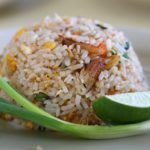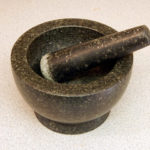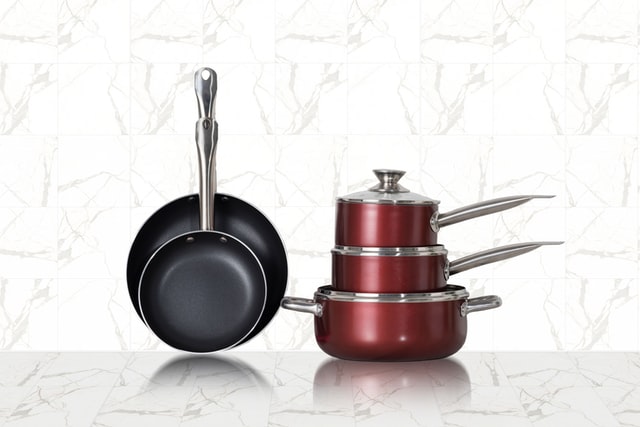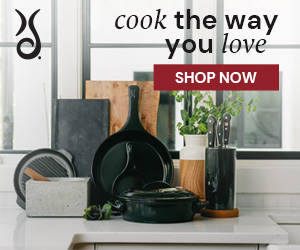On this page, I want to go into some of the essentials of Thai cooking. What I mean by this is both the fundamental and more exotic cookware you’ll need in your kitchen to build a good repertoire of Thai dishes.
This page provides enough resources to cook everything in my Thai recipe book, Thai Food At Home, which you can get for free.
(Disclaimer: this page contains affiliate links.)
Basic Thai Cookware
The basics that follow are what you absolutely need in your kitchen. I don’t recommend getting started on any Thai dish without having each one of these at hand in your cooking area.
Rice Cooker

Rice is the staple food of Thailand. There is absolutely no point in cooking rice on the stovetop; it’s much more difficult to get right and much less convenient than a rice cooker.
The Guardian newspaper released a Lifestyle article in 2020 saying you shouldn’t buy cookware that contains an ingredient’s name. I fundamentally disagree with that advice, and the necessity of a machine to cook rice in is why.
These appliances come in a bewildering array of price ranges and features. Personally, I prefer something cheap, easy-to-operate, and durable. In fact, I have an entire page dedicated to my preferred affordable rice cooker option.
If you’d rather just get the name of the machine I prefer without reading that page, I recommend the Zojirushi NHS-10. It’s worth noting that Zojirushi is one company of five that made it onto my recommendations for the best top of the line cookware.
I’ll link out to some in-depth test reviews of the different models I’ve tried as I review them individually.
Update: I tried the Zojirushi Micom, a more expensive rice cooker. See what I thought here. I also reviewed the Cuckoo CRP-P0609S.
Pestle and Mortar

Much of Thai cooking requires elbow grease. You need to be willing to bash ingredients up in a pestle and mortar and extract their oils and other flavors. Many Thai dishes, from curry pastes to salads, begin with a pestle and mortar.
You can take a shortcut and use a food processor. This is fine if you are stuck for time. However, I strongly recommend getting two types of pestle and mortar if you are serious about learning to cook Thai food:
- Granite pestle and mortar
- Clay pestle and mortar
The granite mortar is for the heavy-duty bashing of ingredients to extract oils and maximize the flavor from them. Curry pastes and many Thai stir-fried dishes all begin inside a sturdy, granite mortar. Read about my recommended best granite pestle and mortar for Thai food.
A clay mortar is more for gently bruising and mixing ingredients. In Thai cuisine, the most famous use of a clay mortar is when making som tam, a type of unripe papaya salad.
Wok
Alongside a rice cooker, a wok is a quintessential piece of equipment used in pretty much all East Asian cuisines. You’ll see woks in pretty much every kitchen from Chiang Mai to Chaiyaphum.
These tools are incredibly versatile for any kitchen. Did you know that you can do all of the following cooking methods with just a wok?
- Boil
- Stir-fry
- Sear
- Steam
Woks come in several different materials. The only two materials I recommend are carbon steel woks and ceramic woks. And I’ll explain why.
Carbon steel woks are the best materials for ease of cooking. They are naturally non-stick, which is a big deal when stir-frying. Furthermore, they retain this non-stick characteristic consistently over time.
Ceramic woks are a fantastic eco-friendly and healthy alternative. It’s not that steel woks are really unhealthy but many types of woks release toxic fumes at certain heat levels. Ceramic is a 100% non-toxic option, and the products by a company named Xtrema are particularly good.
If you held a gun to my head and asked me for one particular wok recommendation, my choice would be the Hand-Hammered Carbon Steel Pow Wok by Craft Wok. It really is a superb piece of equipment that is easy to maintain and has retained its non-stickability’ (that’s a word, right?) for over 5 years for me.
In terms of other materials, I did try a cast-iron wok made by premium French company Le Creuset. You can check out my thoughts on the Le Creuset wok here.
In terms of wok cooking, I also have a page on the main accessories for wok cooking.
Note that I don’t really fry my eggs in woks. I tend to use a separate dedicated pan. Read my recommendations on the best non stick egg pans here.
If you want a budget frying pan that isn’t specifically Thai cookware related, check out my review of Copper Chef pans, the company behind a rather quirky informercial.
Knife Set
I can’t overstate the importance of a quality set of knives when it comes to cooking any cuisine; not just Thai food. It might be a controversial statement, but in my eyes, having quality knives makes cooking at least 50 percent easier and more efficient.
Before you think of even looking for more esoteric equipment, such as sticky rice bamboo steamers, invest in some quality blades. They make tasks such as cutting up meat and chopping vegetables so much easier.
When I first began cooking, I used the 15-year-old crappy knives that had been wasting away in our kitchen drawer. It was a nightmare to do such basic things as cutting an onion in half or dicing a tomato.
There is no need to put yourself through the torture of using blunt, inefficient cookware. One of the things that strikes you most when you watch Thai vendors or chefs preparing food in Thailand is that they’ll always have incredibly sharp knives at hand.
In terms of recommended knives, I can vouch for the ones I use, which are made by an American company named Regalia.
For Thai cooking, you’ll need the following three types of knives at a minimum:
- Chef’s Knife—a multi-purpose type of knife used for many different kitchen tasks, such as slicing and cutting vegetables or mincing meat. Read why I consider this the best value knife for amateur chefs.
- Cleaver Knife—large knife for hacking through bones, hard fruits like pineapple, or crushing ingredients. Very common in Thailand.
- Paring Knife—perfect for peeling fruits and veggies in addition to performing intricate, complex tasks like taking veins from shrimp.
If you’d like a buyer’s guide on the most affordable chef knives, check that link out. I’ve also reviewed the Calphalon SharpIn knife set.
Wok Spatula and Ladle
Getting a proper spatula for stir-frying is arguably as important as getting a good wok in the first place. If you ever watch people cooking in Thailand, you’ll notice the ease with which they stir-fry ingredients and toss them around in the pan. This ease comes from the shovel-style tip of a good spatula that enables you to toss the ingredients around the wok with very little effort.
While a spatula isn’t a piece of cooking equipment, I feel it is vital to include here. It doesn’t matter what wok I recommend if you can’t efficiently cook in it. That’s what a spatula is for.
It’s a similar case for a ladle. Again, not strictly a piece of cookware but you’ll need one when cooking Thai food. The ladle is for pouring oil, stock, or other liquids into the wok.
Personally, I recommend the Sunrise Wok Shovel & Ladle Set. Not only is the spatula itself excellent for stir-frying but the ladle is also top-class. Both are made from durable, commercial-quality stainless steel. Both have wooden handles that make them easier to grasp even if you’re hot and sweaty.
Pots/Saucepans
Soups are a huge part of Thai cooking, and you’ll need a saucepan to cook them in. I don’t advocate the need to have tons of different pots and saucepans. One or two high-quality products will suffice.
If you ever plan on cooking glutinous rice, an essential part of North and Northeast Thai food, you’ll need a saucepan to steam it over. Much like woks, saucepans come in a huge variety of materials.
Here are some sets I’ve taken a look at:
- I reviewed the popular Rachael Ray 12-piece set. Check it out and see if it’s worth the money.
- I also made a recommendation for a Cuisinart set of pots and pans.
- I reviewed the Proclamation Duo, a unique set for minimalist cooks.
- Check out my opinion of the Anolon Advanced Home set here. This set was made by the biggest cookware distributor in the United States.
- I reviewed the non-toxic GreenPan ceramic Venice Pro set here.
- Meyer’s Farberware range gets the Thai Food Paradise review treatment here.
- You might also be interested in my thoughts on the Calphalon Tri Ply 13-piece stainless steel set.
‘Exotic’ Thai Cookware
For the hardcore fanatic who wants to recreate pretty much any dish from this amazing cuisine. The exotic list of equipment spans dishes you’ll likely eat (and love most) if you really delve into Thai food. Not essential by any means but definitely recommended if you get serious about the food of the Land of Smiles.
Thai Hotpot Grill
Eating hotpot (kra ta) in Thailand is one of the most fun culinary experiences you can have. Thankfully, it’s possible to recreate the kra ta experience by buying a high-quality hotpot with grill.
You gather around with family and friends, load up the centre of the hotpot with some soup, add vegetables, and grill your favourite protein on the grill section of the hotpot. It’s an extremely fun shared eating experience that I can’t recommend enough.
Sticky Rice Bamboo Steamer
Crucial for properly cooking the staple food of the North and Northeast of Thailand: khao niew (sticky rice). The bamboo steamer is a traditional piece of equipment that’s been used for hundreds of years.
Personally, I like to go for a combo of steamer and pot. I like the funky, funnel-shaped pots you often get with these bamboo steamer combos. They have a very traditional Siam design, and they remind me of being in the Land of Smiles.
Thai Clay Hotpot
These clay hotpots are often used in Thailand to eat jim jum, which is a hotpot dish very often eaten in Isaan and North Thailand. The dish is very warming and a communal way of eating.
The clay hotpot rests on a charcoal stove. Pork or chicken broth is added to the pot and you cook the ingredients yourself at the table. Most commonly, you’re given a set of fresh herbs, vegetables, some eggs, some meat, and spicy dipping sauces to enhances the flavor.
Thai Soup Hotpot
Thai soup hotpots are fabulous pieces of cooking equipment that you can use to serve soup at the dinner table. These are excellent options if you are having a dinner party or you just want to be a little bit fancy. By lighting a small candle and placing it into the small chamber, you can easily and stylishly keep your soup nice and hot.
Thai Clay Charcoal Grill
Known as a tao, this outdoor charcoal grill is a majestic, old-school piece of cooking equipment that gives you the tastiest grilled meat you’ve ever eaten. If you want smoky grilled pork, beer, or even shrimps and you have the space to cook outdoors, get yourself one of these and thank me later.
Takoyaki or Kanom Krok Pan
Kanom krok is a type of Thai dessert/snack that I absolutely adore. The thing is, you need a special appliance to cook these little pieces of coconut-flavored heaven in.
In Thailand, you can get special kanom krok pans. An alternative is the Japenese Takoyaki pan, which is more than suited to the task. Thankfully, Takoyaki pans are easy to find: you can get them one on Amazon.
Check out the below products if you want to get yourself some exotic Thai cookware. I can particularly recommend the Thai hotpot; it’s a great investment.





